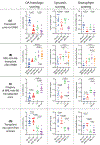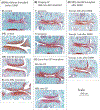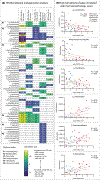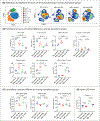OA susceptibility in mice is partially mediated by the gut microbiome, is transferrable via microbiome transplantation and is associated with immunophenotype changes
- PMID: 37979958
- PMCID: PMC10922159
- DOI: 10.1136/ard-2023-224907
OA susceptibility in mice is partially mediated by the gut microbiome, is transferrable via microbiome transplantation and is associated with immunophenotype changes
Abstract
Objectives: The Murphy Roths Large (MRL)/MpJ 'superhealer' mouse strain is protected from post-traumatic osteoarthritis (OA), although no studies have evaluated the microbiome in the context of this protection. This study characterised microbiome differences between MRL and wild-type mice, evaluated microbiome transplantation and OA and investigated microbiome-associated immunophenotypes.
Methods: Cecal material from mixed sex C57BL6/J (B6) or female MRL/MpJ (MRL) was transplanted into B6 and MRL mice, then OA was induced by disruption of the medial meniscus surgery (DMM). In other experiments, transplantation was performed after DMM and transplantation was performed into germ-free mice. Transplanted mice were bred through F2. OARSI, synovitis and osteophyte scores were determined blindly 8 weeks after DMM. 16S microbiome sequencing was performed and metagenomic function was imputed. Immunophenotypes were determined using mass cytometry.
Results: MRL-into-B6 transplant prior to DMM showed reduced OA histopathology (OARSI score 70% lower transplant vs B6 control), synovitis (60% reduction) and osteophyte scores (30% reduction) 8 weeks after DMM. When performed 48 hours after DMM, MRL-into-B6 transplant improved OA outcomes but not when performed 1-2 weeks after DMM. Protection was seen in F1 (60% reduction) and F2 progeny (30% reduction). Several cecal microbiome clades were correlated with either better (eg, Lactobacillus, R=-0.32, p=0.02) or worse (eg, Rikenellaceae, R=0.43, p=0.001) OA outcomes. Baseline immunophenotypes associated with MRL-into-B6 transplants and MRL included reduced double-negative T cells and increased CD25+CD4+ T cells.
Conclusion: The gut microbiome is responsible in part for OA protection in MRL mice and is transferrable by microbiome transplantation. Transplantation induces resting systemic immunophenotyping changes that correlate with OA protection.
Keywords: Inflammation; Osteoarthritis; Osteoarthritis, Knee.
© Author(s) (or their employer(s)) 2024. No commercial re-use. See rights and permissions. Published by BMJ.
Conflict of interest statement
Competing interests: None declared.
Figures




References
MeSH terms
Grants and funding
LinkOut - more resources
Full Text Sources
Research Materials
Miscellaneous

